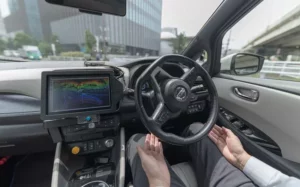The Transport Committee has published its report on the future of self-driving vehicles and how the Government should approach their introduction to the UK’s roads.
The cross-party Committee makes a number of recommendations on how regulations should be updated to tackle concerns about safety and security, dilemmas over legal liability, as well as infrastructure that will be needed to accommodate their introduction.
The Committee heard that current laws for SDVs are “archaic and limiting”, especially concerning testing and legal liability. Witnesses said the sector is “crying out” for regulation. The Committee commended the work of the Law Commissions and the Government in devising a new legal framework, Connected & Automated Mobility 2025. It says that framework has broad support, albeit with more detail needed in some areas and in a statement says this makes it “disappointing that the Government has not committed to legislating in this Parliament to put this framework in place”.
The statement continues:
The SDVs sector is a British success story, and the UK has a competitive advantage that we must maintain. The Committee urges Government to pass comprehensive legislation in the next parliamentary session to put in place the robust regulatory framework it promised. This should cover vehicle approvals, liability for accidents, cybersecurity, and the use of personal data. Failing to do so will do significant and lasting damage both to the UK’s SDVs industry and the country’s reputation as a trailblazer.
While it is widely assumed that SDVs will prove safer than human drivers, this is not a given. The Committee heard that optimistic predictions often rely on SDVs becoming widely used on UK roads, which could be decades away, or assertions about human error that ignore other risks. Safety must remain the Government’s overriding priority as SDVs encounter real-world complexity. Given this, MPs question the Government’s proposed ‘safety ambition’ – that self-driving vehicles will be “expected to achieve an equivalent level of safety to that of a competent and careful human driver” – believing it is “too weak and too vague”. The Government should set a clearer, more stretching threshold.
Greater automation will reduce time spent driving, leading to concerns that drivers may become less practised and therefore less skilled over time. Conversely, the requirement for drivers to be ready to take manual control of a vehicle means a risk of facing challenging scenarios with little notice. The Committee recommends that Government should set out a strategy for the future of human driving in a world of SDVs. This should include possible changes to driving tests and a plan to ensure all drivers fully understand SDVs. The Committee also argues this should not impose new responsibilities on other road users and pedestrians or make them less safe.
SDVs pose cybersecurity risks because of their connected rather than automated capabilities. This poses new dangers, which the law must evolve to meet. A safety-led culture will require wide access to data.
Ensuring SDVs are roadworthy will be more complicated than for conventional vehicles as there is more that can go wrong. Legal liability also becomes more complex as it is shared between owner and vehicle software operators. This may cause problems for the insurance industry. The Government explained broadly how its new regulatory regime will work but accepted that more thinking was needed about how this will work in practice. The Committee urges the Government to take a lead on these issues.
Self-driving vehicles will need well-maintained roads – an issue many road users already feel should be a high priority – as well as signage, nationwide connectivity, and up-to-date digital information about the road network. While some steps have been taken towards this by the Government and public bodies, these preparations are too siloed and divorced from broader planning. If the Government is serious about SDVs it should ensure meeting their needs is an integral part of future infrastructure strategy.
The Committee heard there is a range of possible uses for SDVs, including with HGVs, buses, taxis and private cars. It believes that, in time, SDVs have the potential to improve connectivity and provide significant benefits for safety and productivity in industries such as logistics.
However, the Government must take a cautious, gradual approach with the technology introduced only in well-defined and appropriate contexts. As such, the Committee broadly welcomes the Government’s strategy set out in August 2022. However, without careful handling, there are concerns that SDVs could worsen congestion and exacerbate inequalities in transport access if, for example, self-driving private hire vehicles are unable to offer the same assistance to disabled people as human-driven ones. Government must ensure the introduction of SDVs is responsive to the wider population and meets the UK’s transport policy objectives, which are the subject of a separate inquiry by the Transport Committee.
Transport Committee Chair Iain Stewart said: “Thanks to the energy and creativity of the self-driving vehicles sector, the UK has a head start in developing a vision for how SDVs could be introduced. The Government’s strategy is one this Committee broadly welcomes.
“Self-driving vehicles are a great British success story in the making and we have a competitive advantage over many other countries. But all that hard work could be at risk if the Government doesn’t follow through and bring forward a Transport Bill in the next Parliamentary session, before the next general election.
“Widespread take-up of SDVs faces various hurdles, including public confidence in their safety, security and their potential to have knock-on impacts on other road users. If the Government is going to meet its ambitions for self-driving vehicle deployment these knotty issues need to be addressed. We believe the Government should take a cautious, gradual approach, with SDV technologies only initially introduced in well-defined contexts, or else we risk unintended consequences.”
(Picture – Yay Images)





















